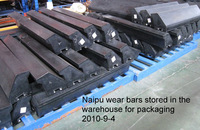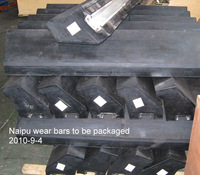- Pumps[10]
- Other Mining Machinery[6]
- Mine Mill[7]
- Vibrating Screen[2]
- Mineral Separator[10]
- Mining and Metallurgy Projects[1]
- Contact Person : Ms. Peng Huafen
- Company Name : Jiangxi Naipu Mining Machinery And New Materials Co., Ltd.
- Tel : 86-0793-8461032
- Fax : 86-0793-8461032
- Address : Jiangxi,Shangrao,No. 4, Industry Road,Xuri County,Economy development Zone,Shangrao
- Country/Region : China
- Zip : 334100
wear resistant grinding rubber mill
Wear resistant grinding rubber mill
I. Features of rubber liners for grinders:
1. Rubber density is only 1/6 of metal one, and the lighter weight makes an easier installation and disassembly, saves time (to install rubber liners, it takes one-third of the time span for metal ones), greatly reduces workers’ labor intensity and improves the installation safety.
2. The damping, elasticity and absorbing functions of rubber liners reduce noise, and the noise from a rubber-lined grinder is normally lower by 8-10dB than that from one with metal liners.
3. As high wear-resistant rubber liners last much longer than metal ones, the cost-performance ratio of rubber liners is higher than that of metal ones.
II. Structural features of rubber liners:
1. Rubber liners for O/F type grinders
(1)As rubber friction resistance is higher than that of metal, rubber reverse spirals in the DE trunnion liner yield a high rate of returned materials to the mill.
(2)It can effectively improve the throughput of a grinding mill by changing height, spacing and pattern of lifter bars.
2. Structural Features of Grate Mills:
Thanks to the improved evasive property resulting from flexible inserts between apertures of them, the rubber grates solve undesirable phenomena as of aperture blockage or jam experienced on metal liners, improving the screening efficiency.
3. Structural features of composite liners for SAG Mills:
(1) Rubber liners for SAG mills are classified into: normal rubber liners and composite rubber liners.
(2) Normal rubber liners use normal metal as skeleton inserts and abrasion resistant rubber as working surface, and are vulcanization molded in molds, mainly used as FE and DE head liners in small SAG mills.
(3) Composite liners use normal steel plate, abrasion resistant rubber plus imported abrasion resistant HDS steel plate in combination, and are high pressure vulcanization molded in molds. Alloy steel embedded on the working surface of composite liners has abrasion and impact resistant performance two times better than that of normal manganese steel. Abrasion resistant rubber effectively protects the shell from impact, lowers noise and reduces wear on shell wall.
(4) Composite liners are of simple structure, light in weight and easy for installation and maintenance.
(5) Compared with that of normal metal liners, the cost-performance ratio of composite liners is higher.
III. A Typical Case:
Results of rubber liners and metal liners applied on 8.5x4m SAG mill at Tongling Dongguashan Mine are as follows:
Parts Name | Before Upgrading | After Upgrading (Rubber Parts) | Comparison of Use |
1. Outer pulp lifter | Metal part: over 1 year of service life. Rubber part: 36 months of service life expected (already used for 11 months). | ||
2. Middle pan liner | Metal part: 12~18 months of service life. Rubber part: 24~32 months of service life expected. | ||
3. Cover plate | Rubber liner made by Naipu | Metal part: 12 months of service life. Rubber part: 24 months of service life expected. | |
4. Inner pan liner | Rubber liner made by Naipu | Rubber part imported: 20 months of service life. Rubber part made by Naipu: 20 months of service life. Equal to imported parts. | |
5. Center plate | Rubber liner made by Naipu | Rubber part imported: 20 months of service life. Rubber part made by Naipu: 20 months of service life. Equal to imported parts. |
2. Conditions applicable for rubber liner of ball mill:
2.1 Hardness of ore: the relationship of the rates of wear and the hardness of ore for both rubber mill liners and metal mill liners is illustrated in Figure 1. The comparison of rubber mill liners with metal mill liners shows that the harder the ore is, the better wear resistance the rubber liners offer than the metal ones do. Therefore rubber liners are more suitable for application in an environment where the hardness is higher in a ball mill;
2.2 Diameter of steel ball: the steel balls selected for a rubber-lined mill should generally be about 100mm in diameter. Refer to Figure 2 for more info;
2.3 Slurry temperature: the temperatures inside a ball mill with rubber liners should generallyrange within 80 deg C;
2.4 Slurry pH: the slurry pH in a ball mill with rubber liners may range between 2-14.
3. Structural characteristics:
To a large extent, the life of rubber liners depends on their structural modes, among which the height B of the lifter bar, the spacing A between two lifter bars and the shape of the lifter bar play a major role. Figure 3 shows a typical cross section of rubber mill liners. A rationally designed height of the lifter bar not only raises the grinding efficiency of a ball mill, but also extends the service life of rubber liners. Refer to Figure 4 for the schematic view of the status of material movement.
4. Concerning the application of mills under different conditions, we have designed mill liners with a variety of specifications. They consist of rational compositions and are highly wear-resistant, while the framework material in mill liners applies structural sections of premium aluminum alloy. Refer to the following figures for the views of some rubber mill liners produced by our company.
wear resistant grinding rubber mill







